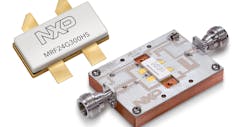As expected, the fifth generation (5G) of wireless cellular communications technology was the “talk of the town” in Boston at the 2019 IEEE International Microwave Symposium, from manufacturers involved in everything from active and passive components to complete systems and test equipment for evaluating them. It became apparent on the exhibition floor that 5G is no longer just a “hoped-for” application for millimeter-wave (mmWave) technology, but is well along in the development stage in many parts of the world, notably in the Far East.
One company that showed an integrated portfolio of high-frequency semiconductor solutions for 5G infrastructure applications was NXP Semiconductors N.V. (Booth 548), displaying a comprehensive suite of solutions for 5G power amplification at the 2019 IMS exhibition. The lineup includes multichip modules (MCMs) for use from under 6 GHz to 40 GHz, with output power levels from milliwatts to kilowatts.
“With the potential to transform entire industries and economies, 5G will be fully realized over time and NXP is uniquely positioned to facilitate its global adoption by offering one of the industry’s most comprehensive cellular infrastructure portfolio focused on driving the 5G connected world,” said Paul Hart, senior vice president and general manager of NXP’s Radio Power Solutions. “Today, NXP is ahead of the demand curve as the world’s top supplier of massive-MIMO solutions enabling carriers to provide more bandwidth to customers.”
NXP’s devices are already enabling many developing 5G infrastructure systems around the world. For example, the company offers smart antennas with analog beamforming capabilities from 24 to 40 GHz. They antennas are based on the firm’s silicon-germanium (SiGe) technology for 5G and high-efficiency power amplifiers. Representatives also showed many discrete high-power gallium-nitride (GaN) transistors for commercial, industrial, medical, and military applications.
This high-power GaN-on-SiC transistor, which delivers as much as 330 W CW output power at 2.4 GHz, is shown here next to a demonstration circuit board. (Courtesy of NXP Semiconductors)
In fact, NXP made news at the show with the introduction of its model MRF24G300HS, a GaN-on-silicon carbide (GaN-on-SiC) RF power transistor with high efficiency exceeding that of magnetrons at 2.45 GHz under continuous-wave (CW) operating conditions (see figure). Making it possible to create microwave heating devices at a fraction the size of magnetron tubes, these power transistors operate at 50 V and provide 330 W CW output power at 2.4 GHz.
“The smart control, low maintenance, and ease of use of solid-state open the door to new use cases, such as smart cooking and Industry 4.0 heating machines,” said Paul Hart, senior vice president and general manager of NXP’s Radio Power Solutions. “By breaking the efficiency barrier of vacuum tubes, we enable our customers to unlock innovation without any compromise on performance.”
Right on the same part of the IMS show floor (Booth 532), MACOM was also quite visible with the introduction of its model MAAP-011-250 balanced 4-W power amplifier (PA) for satellite-communications (satcom) applications from 27.5 to 30.0 GHz. Meant to complement the company’s Ka-band mixers, driver amplifiers, and PAs, the 4-W PA provides 24-dB linear gain with output third-order intercept point (OIP3) of +41 dBm when biased with +6 V dc. The IC amplifier can be used as a driver amplifier stage or a PA as part of high-performance broadband wireless data links.
About the Author
Jack Browne
Contributing Editor
Jack Browne, Technical Contributor, has worked in technical publishing for over 30 years. He managed the content and production of three technical journals while at the American Institute of Physics, including Medical Physics and the Journal of Vacuum Science & Technology. He has been a Publisher and Editor for Penton Media, started the firm’s Wireless Symposium & Exhibition trade show in 1993, and currently serves as Technical Contributor for that company's Microwaves & RF magazine. Browne, who holds a BS in Mathematics from City College of New York and BA degrees in English and Philosophy from Fordham University, is a member of the IEEE.


